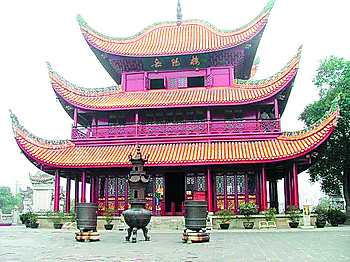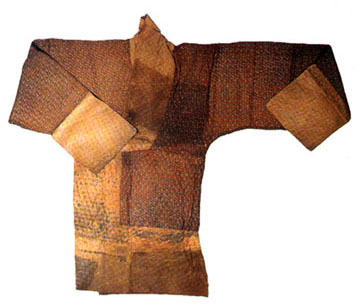Changsha, as the
capital of
Hunan Province in south central
China, Changsha is at the center of a rich agricultural region amid
the Hunan plains and bordering the Xiang River. The site has a
3,000-year history of occupation, and was an important center of the
southern Chu State culture in the Warring States period (5th-3rd c.
BC). The lacquerware and silk textiles recovered from a Western Han
(2nd century BC) tomb at Changsha are an indication of the richness
of local craft traditions. In 1904 Changsha was opened to foreign
trade, and large numbers of Europeans and Americans settled there.
Mao Zedong was born in nearby Shaoshan, and he studied and taught at
Changsha. Today Changsha is an important commercial center and river
port, with abundant light industrial production.

Yueyang Tower (Yueyanglou) |
Yueyang Tower (Yueyanglou)
Yueyang Tower is one of the most famous structures in China, renowned
for its ancient literary associations. It stands on the northeastern
shore of Lake Dongting in Hunan Province in the riverside city of
Yueyang, where the Yangzi River intersects with the lake via canals.
Originally built in 716, the present tower was rebuilt in 1045 on
another site, and restored in the early Qing and again as recently as
1983. In the Tang period, at the height of Chinaís literary glory, the
original tower was a meeting place for famous poets such as Li Bai, Du
Fu, and Bai Juyu. In the early Song period the tower was associated with
the literary man Fan Zhongyan (989-1052). The three-story tower is 20m
(66 ft.) high, constructed without cross-beams or nails. It includes
four main halls and 24 outer and 12 inner rooms. Three upward-curving
roofs covered with glazed yellow tiles are supported by huge red
pillars. The top of the Tower offers broad vistas of Lake Dongting.
Mawangdui: Spirit-World of a Han Dynasty Noblewoman
The early Han period (early 2nd century BC) tombs of a noble family
excavated at Mawangdui are among the most important archaeological
discoveries of the past quarter-century. The astonishing state of
preservation of one of the tombs, including the mummified corpse of the
occupant, and vulnerable materials such as lacquer-painted wood and silk
textiles, are only part of the story.
The intact contents of the
tomb offers unparalleled insights into burial practices and beliefs in
the after-life for the far southern culture of early imperial China. In
addition, the tomb contains manuscript texts of versions of classic
scriptures from early Chinese philosophical schools, shedding important
light on the development of early Chinese thought. Further, the tombs
contained silk funerary paintings, which offer insights into early
imperial period mythologies and cosmological beliefs.

Clothes from 2000 years ago -
excavated at Mawangdui |
The tombs were discovered
in 1972 during construction work at Mawangdui, about 4 km northeast of
Changsha, and excavation was completed in 1974. The best preserved, and
entirely undisturbed tomb, was that of the Marquess of Dai, or Xin Zui,
buried about 180 BC, whose husband was a minor nobleman in charge of
administering the region of Changsha. Their sonís tomb was nearby.
The tombs were marked only
by two earthen mounds above ground; the actual tomb chambers were 16
meters underground, accessed from the north via a sloping passageway.
The tomb walls were surrounded by layers of charcoal and pounded clay,
which seem to have been instrumental in keeping the moisture level
constant and preventing the decay of the corpse and other tomb contents.
Among many other remarkable finds, a painted T-shaped silk funerary
banner, a so-called spirit robe, was laid over the innermost coffin. The
banner has a cord, which may indicate that it was carried in a funerary
procession before being draped over the coffin. Since silk is a
perishable material, the discovery of a silk painting with
well-preserved ink and brilliant color designs near 2,200 years old was
a major event, matched by only a very few other painted silks of
comparable age.
Juzizhou Islet, Changsha
Located in the central part of Xiangjiang River in south China, Juzizhou
Islet is known all over China because of Mao Zedong's poem 'Qin Yuan
Chun Changsha'. The islet is a picturesque park with beautiful pavilions
and corridors. It has had free admission since April 2009.
Since June 1 of 2010, all parks in Changsha City, Hunan Province have
been free to the public, including the well-known Yueli Mountain scenic
attraction. (source: China.org.cn)




